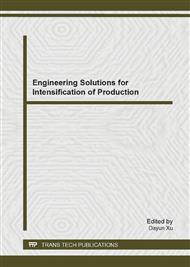[1]
Arsecularatne, J.A., Zhang, L.C., Montross, C., Wear and tool life of tungsten carbide, PCBN and PCD cutting tools, International Journal of Machine Tools & Manufacture 46 (2006) 482-491.
DOI: 10.1016/j.ijmachtools.2005.07.015
Google Scholar
[2]
Liang, Y.T., Chiou, Y.C., Vision-Based Automatic Tool Wear Monitoring System, Proceedings of the 7th World Congress on Intelligent Control and Automation (2008).
DOI: 10.1109/wcica.2008.4592857
Google Scholar
[3]
Kurada, S., Bradley, C., A machine vision system for tool wear assessment, Triblogy International vol. 30, issue 4 (1997) 295-304.
DOI: 10.1016/s0301-679x(96)00058-8
Google Scholar
[4]
Constantinides, N., Bennett, S., An investigation of methods for the on-line estimation of tool wear, Int. J. Math. Tools Manufact. vol. 27, No. 2 (1987), 225-237.
DOI: 10.1016/s0890-6955(87)80052-4
Google Scholar
[5]
Luttervelt, C.A., Childs, T. H.C., Jawahir, I.S., Klocke, F., Venuvinod, P.K., Present Situation and Future Trends in Modelling of machining Operations: Progress Report of the ClRP Working Group Modelling of Machining Operations, CIRP Annals – Manufacturing Technology 47 (1998).
DOI: 10.1016/s0007-8506(07)63244-2
Google Scholar
[6]
Lee, J.H., Kim, D.E., Lee, S.J., Statistical analysis of cutting force ratios for flank-wear, International Journal of Material Processing Technology 74 (1998) 104-114.
DOI: 10.1016/s0924-0136(97)00256-2
Google Scholar
[7]
Bouacha, K., Yallese, M.A., Mabrouki, T., Rigal, J.F., Statistical analysis of surface roughness and cutting forces using response surface methodology in hard turning of AISI 52100 bearing steel with CBN tool, Int. Journal of Refractory Metals & Hard Materials 28 (2010).
DOI: 10.1016/j.ijrmhm.2009.11.011
Google Scholar
[8]
Hastings, W.F., Mathew, P., Oxley, P.L.B., A machining theory for predicting chip geometry, cutting forces etc. from work material properties and cutting conditions, Proceedings of the Royal Society A 371 (1980) 569-587.
DOI: 10.1098/rspa.1980.0097
Google Scholar
[9]
Heiple, C.R., Carpenter, S.H., Armentrout, D.L., McManigle, A.P., Acoustic emission from single point machining-Source mechanisms and signal changes with tool wear, Materials Evaluation 52 (1994) 590–596.
Google Scholar
[10]
Wanigarathne, P.C., Kardekar, A.D., Dillon, O.W., Poulachon, G., Jawahir, I.S., Progressive tool-wear in machining with coated grooved tools and its correlation with cutting temperature, Wear 259 (2005) 1215-1224.
DOI: 10.1016/j.wear.2005.01.046
Google Scholar
[11]
Bonifacio, M.E.R., Diniz, A.E., Correlating tool wear, tool life, surface roughness and tool vibration in finish turning with coated carbide, Wear 173 (1994) 137-144.
DOI: 10.1016/0043-1648(94)90266-6
Google Scholar
[12]
Huang, S.N., Tan, K.K., Wong, Y.S., de Silva, C.W., Goh, H.L., Tan, W.W., Tool wear detection and fault diagnosis based on cutting force monitoring, International Journal os Machine Tools & Manufacture 47 (2007) 444-451.
DOI: 10.1016/j.ijmachtools.2006.06.011
Google Scholar
[13]
Smithey, D.W., Kapoor, S.G., DeVor, R.E., A new mechanistic model for predicting worn tool cutting forces, Machining Science and Technology 5 (2001) 23–42.
DOI: 10.1081/mst-100103176
Google Scholar
[14]
Das, S., Chattopadhyay, A.B., Murthy, A.S.R., Force Parameters for On-lineTool Wear Estimation: A Neural Network Approach, Neural Networks vol 9 (1996) 1639-1645.
DOI: 10.1016/s0893-6080(96)00036-6
Google Scholar
[15]
Noori-khajavi, A., Komanduri, R., On multisensor approach to drill wear monitoring, Annals of the CIRP 42 (1993) 71–74.
DOI: 10.1016/s0007-8506(07)62394-4
Google Scholar
[16]
Luo, R.C., Kay, M.G., Multi-sensor integration and fusion in intelligent systems, IEEE Transactions on Systems, Man and Cybernetics 19 (1989) 901–931.
DOI: 10.1109/21.44007
Google Scholar
[17]
ISO - International Organization for Standardization, Tool Life Testing with Single Point Turning, (1993).
Google Scholar
[18]
Boulger, F. W., Moorhead, H., Gavey, T.M., Superior Machinability of MX Steel Explained, Iron Age 167 (1951) 90-95.
Google Scholar
[19]
Czaplici, L., Lúsinabilite et al Coupe des Metaux", Res. Soc. Roy. Belge Ingeniere 12 (1962) 708-736.
Google Scholar
[20]
Jawahir, I. S., Li, P. X., Gosh, R., Exner, E. L., A new parametric approach for the assessment of comprehensive tool wear in coated grooved tools, Annals of the ClRP 44 (1995) 49-54.
DOI: 10.1016/s0007-8506(07)62273-2
Google Scholar
[21]
Ee, K.C., Balaji, A.K., Li, P.X., Jawahir, I.S., Force decomposition model for tool-wear in turning with grooved cutting tools, Wear 249 (2002) 985-994.
DOI: 10.1016/s0043-1648(01)00837-7
Google Scholar
[22]
Choundhury, S.K., Kishore, K.K., Tool wear measurement in turning using force ratio, International Journal of Machine Tools and Manufacture 40 (1999) 889-909.
DOI: 10.1016/s0890-6955(99)00088-7
Google Scholar
[23]
Yellowley, I., Lai, C.T., the use of force ratios in the tracking of tool wear in turning, Transactions of ASME 115 (1993) 370-372.
DOI: 10.1115/1.2901676
Google Scholar


